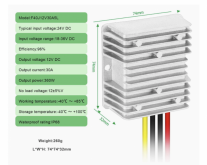Barbar0ssa
New Member
- Joined
- Mar 3, 2021
- Messages
- 80
I picked up a 24v 30a dc-dc buck converter to drive a pond aerator (100w) off of a solar panel and inverter without batteries. The solar panel had 22.1v the buck converter showed regulated 12.2 out. I plugged it into the inverter which beeped, saying it turned on and then nothing. There was no load on the inverter. Now I see no voltage on output of the converter. Are there any tricks I should know or did I just get a dud?





